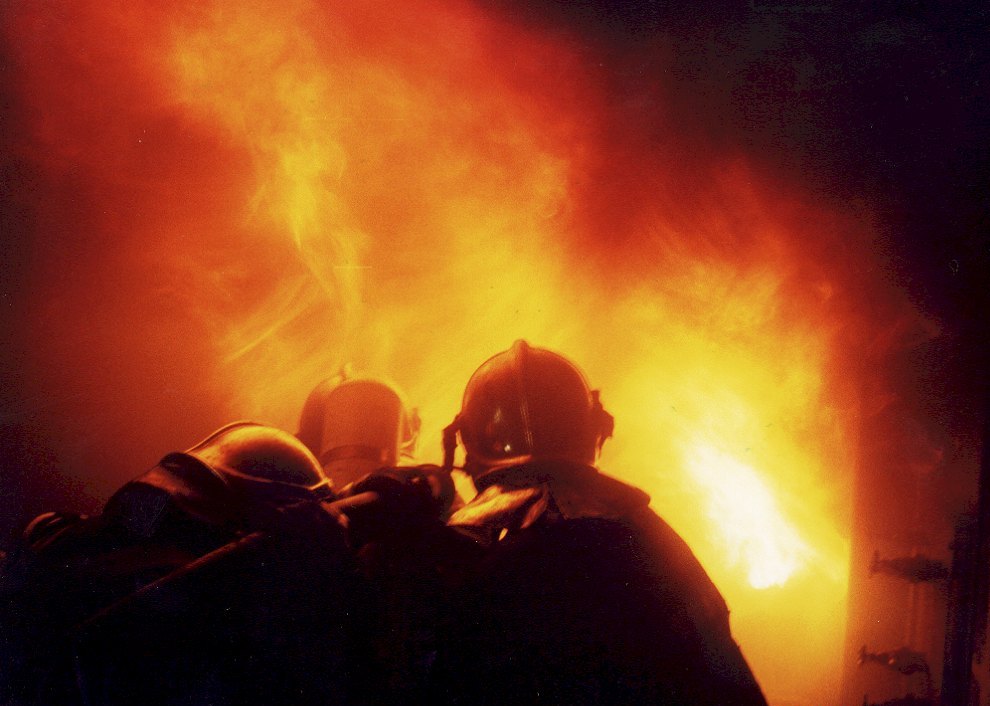
Pic: Fire Service college
In the context of High Rise fire fighting, an Intervention tactic, may be described as :
"Any entry into an area, flat or compartment known (or suspected) to be involved in the incident, to control and ultimately extinguish any fire."
Perhaps the most difficult job a Bridgehead sector commander /IC has is choosing the most appropriate tactical option. This will be informed by training, pre-planned tactical trials, premises risk management information (PRM/SSRI), SOP's, Technical Bulletins, experience and what is actually observed.
A deep and thorough understanding of fire behavior in these building types is key to a safe deployment, This includes an understanding of compartment at ion, smoke travel, fire development, wind driven fires, Flashover, Back draft, fire gas, abnormal (rapid) development.
Selection of any Intervention tactic must be carefully risk assessed with well balanced risk/benefit analysis carried out and recorded.
For the FRS, historically the most dangerous part of a High Rise fire is entry into the compartment. If this is done in an uncontrolled or under resourced way, it can lead to serious injury, death and risk serious escalation of the fire.
At every incident, ultimately there will always be an intervention. Even if the fire is fully suppressed by fixed installation, or by external attack (water towers), entry must be make to confirm the fire is fully extinguished
Selection
It is important the the Incident commander (IC) and the Sector Officer, Bridgehead (SO-B) know the full extent of the incident and the advantages and dis-advantages of any proposed tactical options.
Four Line (with "two lines IN") 
This is the recomended minimum intervention for a suspected wind driven fire. Two teams with a line each (two hose lines) make entry into the affected areas.
A third team, the 'Safety Team', with a hose line stay in the corridore near the flat entrance and maintain a means of egress. They can observe for any sudden escalation and should be in audio range of any DSU/PAS system.
As soon as possible, this should be augmented by a forth team, who act as an additional 'Safety Team', with a hose line stay in the stairwell (ideally protected by any fire resisting compartmentation) and maintain a means of egress. They also observe for any sudden escalation and should be in audio range of any DSU/PAS system.
Three Line 
This is the default intervention. Two teams with a line each (two hose lines) used to effect entry into the affected areas.
A third team, the 'Safety Team', with a hose line stay in the stairwell (ideally protected by any Fire resisting compartmentation) and maintain a means of egress. They can observe for any sudden escalation and should be in audio range of any DSU/PAS system.
Two Line 
Used primarily for Rescue scenarios or where an urgent intervention will have a decisive impact on the fire; typically where the IC feels that the immediate deployment of two lines will have a major impact in mitigating the development, acceleration or fire spread beyond the flat. Crews deployed for a two line intervention MUST be in radio contact with the BA Entry Control Officer (ECO)
This tactic poses an elevated risk, in that the Safety Team are not in place, protecting or monitoring the means of egress (stairwell) when the compartment is opened.
A Safety team should be put in place as soon as possible
One Line 
Used at incidents where the Fire can be seen (through vision panels etc.) and is of a size controllable with a single Jet. Importantly this fast intervention mitigates a much larger fire that may develope if crews wait for a second or third hose line to backup there actions. Most typical of this would be in commercial/retail environment where large open planed areas containing a high fireload that would exceed any amount of water normally available through riser installation. This tactic may also 'hold a fire in check' until a heavier attack can be resourced and staged.
This tactic poses an elevated risk, in that the crews entering the compartment have no initial backup or safety crew. There is no protecting or monitoring the means of egress (stairwell). Second and Safety Team should be put in place as soon as possible.
Zero (No) Line 
Typically these would be the actions by first attending crews usually during the reconnaissance and assessment phase of an incident. They are interventions that will immediately and decisively control the incident with no risk to the Fire fighters. These will very small, confined fires (e.g. small waste bins, overheated food etc) or fires that are 'out on arrival'
They require limited intervention by the FRS and are not associated with BA deployment or the use of Main hose lines.
Prior to the selection of any tactic the IC MUST be fully risk aware and be able to balance any risk against the potential benifits. Moral and peer pressures will be part of this balance BUT they are much less significant to it than any physical risks to firefighting crews.
Any deviation from procedure (operational discression) must be justifiable in terms of risk versus benefit and based upon competant risk assesment by the Incident Commander who must be fully risk aware and know the actions which are normally required as part of operational procedure.
 This link will take you away from www.highrisefire.co.uk Please be aware that we do not necessarily endorse or support the views, opinions and expressions of this site !
This link will take you away from www.highrisefire.co.uk Please be aware that we do not necessarily endorse or support the views, opinions and expressions of this site !
